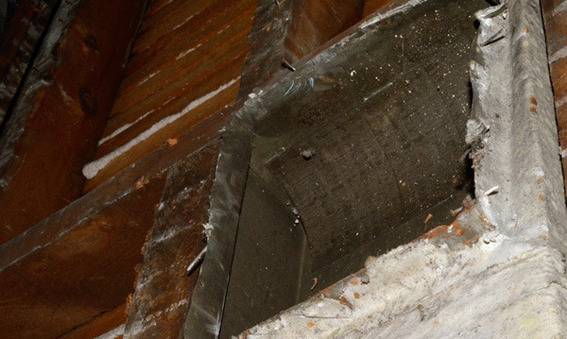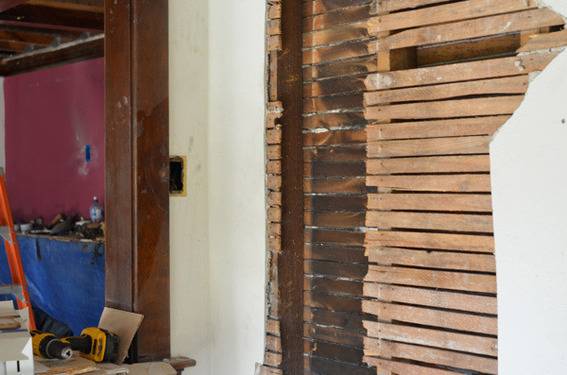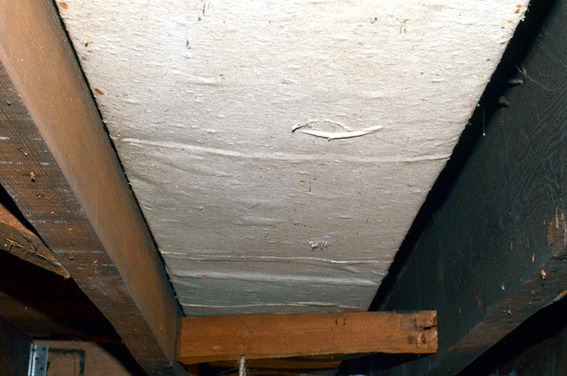If you’re following our series, you know we’re in the middle of fixing up a 100-year-old house and making it energy efficient. Somehow tearing out all the first-floor ceilings got lumped into the to-do list. Then the second floor ceilings. And a couple of walls. And the bathroom. You know … just … everything.
One day you’re just going about your business, gleefully demolishing everything you lay eyes on — a great stress reliever, by the way — and the next day it’s full stop because you find asbestos in the house. Bummer.
So instead of an on-schedule energy upgrade — new HVAC, insulation, and caulking — we added two weeks and thousands of dollars to our project, because we had to bring in an abatement pro, rip out asbestos-wrapped ductwork, and install new ducts.
What is asbestos?
Asbestos, which was used extensively before the 1970s in building materials for fire resistance, often looks like a white or gray paper or tape-like material. Sometimes it’s wrapped around ductwork, pipes, or electrical fittings. Here are a couple of shots of asbestos-clad ductwork — a duct above the dining room and our bathroom register.

The scary thing about asbestos is that the fibers are so small, you can’t see them. There’s no way of detecting asbestos once it’s in your body, but it can cause lung cancer and mesothelioma 20 to 30 years after exposure.
Needless to say, my wife, Alicia, was pretty freaked out, since I’d been working in the house for weeks (most of the time wearing a respirator, but, I admit, not always). And while she was right to be concerned, it’s important not to overreact to these kinds of things.
This line from the Environmental Protection Agency website section on asbestos was the first to catch my eye: “If you think asbestos may be in your home, don’t panic. Usually the best thing is to leave asbestos material that is in good condition alone.”
The EPA has some great resources about asbestos and should be your first stop to find out what you need to know. HouseLogic also has good information about the asbestos abatement process. Based on EPA info and from talking to abatement and HVAC contractors, it seems the greatest health risks come from prolonged exposure to high levels of asbestos. We’re talking about people who worked in asbestos factories for years.
Non-recurring exposure to small amounts of asbestos, while not something to be taken lightly, is way less likely to cause you any problems down the road. In fact, you’ve probably already been exposed (for years it was used in car brakes, drywall, and lots of other building materials).
What do you do with asbestos?
The first thing is to leave it alone; don’t start pulling at it or tearing it out.
If you find asbestos, or something that that you think might contain asbestos — maybe during a big remodeling project like ours — check with local health, environmental, or other appropriate officials about proper handling and disposal procedures, according to the EPA. In my state, Minnesota, I called the state department of health. Your appropriate state agency website may also have a list of certified abatement contractors, so you can get a qualified pro to inspect your home.
Having convinced Alicia that I wasn’t going to keel over just yet (even still, she forbade me from going back in the house without a mask on), we started figuring out what to do.
Although we probably could’ve just covered it back up and forgotten it, we quickly decided the right thing to do was to get it out. We’re hoping to move into this house in July with a three-year-old and a newborn. We’re going to live there for decades. A little extra expense now would buy us a lot of peace of mind later.
After getting a few bids from contractors, we settled on one who clearly explained exactly what would happen during the abatement. He showed us how hazardous materials would be contained, and how he’d monitor the air quality within the home.
Since asbestos is very lightweight and easily airborne, the basic technique to remove it is to get it soaking wet first. That keeps it from fraying and releasing fibers into the air, where they can float around forever and get in your lungs. So, an abatement contractor will set up a containment area using thick plastic, then, wearing protective gear, wet all the asbestos-containing materials down before removing and bagging them.
When it was all over, our ductwork was gone.

The additional cost for all this came to around $5,000 — about half the abatement and half for the new ductwork. That’s a big budget overrun, and when you factor in all the delays to the rest of the project, it turned out to be a huge detour.
But now we can say the house is asbestos-free, and I can get back to putting holes in the walls without a guilty conscience.
Asbestos exposure may cause serious health problems. If during home improvement or maintenance projects you spot material, such as insulation, pipe wrapping, or sprayed-on fireproofing, that may contain asbestos, stop work, don’t disturb the material, and consult with a qualified professional.
This post was originally published on HouseLogic.com.
